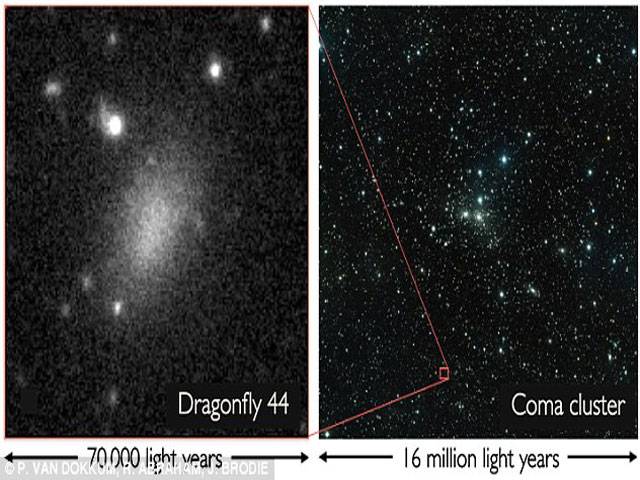Daily Mail
Washington
A group of huge galaxies as wide as the Milky Way, but with just a fraction of its stars, has been spotted by astronomers.
The galaxies are 60,000 light years across - but contain only one per cent of the Milky Way’s stars - making them the most diffuse class of galaxies known in the universe. And they are so diffuse and ‘fluffy’ that scientists are not sure how they have survived.
They have been dubbed ‘fluffy’ because they are so sparse, although the official name for the objects is Ultra Diffuse Galaxies (UDGs).
The team at Keck Observatory made the discovery by combining results from one of the world’s smallest telescopes with the largest telescope on Earth. The smaller of the two telescopes, the Dragonfly Telephoto Array, provided digital images of the very faint, diffuse objects.
And the largest optical telescope in the world, Keck Observatory, then separated the light from one of the faint objects into colours that can be used to work out its composition and distance.
The data showed the diffuse ‘blobs’ are very large - around 60,000 light years across - and very far away, about 300 million light years, rather than small and close by.
And it looks like they may have their own dark matter ‘shields’ that are protecting them.
‘If the Milky Way is a sea of stars, then these newly discovered galaxies are like wisps of clouds’, said lead research Pieter van Dokkum from Yale University.
‘We are beginning to form some ideas about how they were born and it’s remarkable they have survived at all.
‘They are found in a dense, violent region of space filled with dark matter and galaxies whizzing around, so we think they must be cloaked in their own invisible dark matter ‘shields’ that are protecting them from this intergalactic assault.’
The UDGs were discovered near the the Coma cluster, where thousands of galaxies have been drawn together in a mutual ‘gravitational dance’.
‘The big challenge now is to figure out where these mysterious objects came from,’ added fellow researchers Roberto Abraham from the University of Toronto.
‘Are they “failed galaxies” that started off well and then ran out of gas?
‘Were they once normal galaxies that got knocked around so much inside the Coma cluster that they puffed up?
‘Or are they bits of galaxies that were pulled off and then got lost in space?’
The next step for the researchers is the challenging job of trying to work out how much dark matter is present in these objects, which may provide insight into how they were formed.
‘If there are any aliens living on a planet in an ultra-diffuse galaxy, they would have no band of light across the sky, like our own Milky Way, to tell them they were living in a galaxy. The night sky would be much emptier of stars,’ continued team member Aaron Romanowsky from San Jose State University.
Thursday, April 18, 2024
Mystery of the ‘fluffy’ galaxies

3:56 PM | March 28, 2024
4:14 PM | March 23, 2024
Stefanos Tsitsipas advances in Barcelona
4:19 PM | April 18, 2024
Met Office predicts more rains across country till April 29
2:51 PM | April 18, 2024
Punjab changes school timings for summer season
1:55 PM | April 18, 2024
Enemies of Pakistan are unable to digest investment in the country: Ataullah Tarar
1:29 PM | April 18, 2024
IHC restores Bushra Bibi's appeal for shifting to Adiala Jail from Bani Gala
1:24 PM | April 18, 2024
Hepatitis Challenge
April 18, 2024
IMF Predictions
April 18, 2024
Wheat War
April 18, 2024
Rail Revival
April 17, 2024
Addressing Climate Change
April 17, 2024
Justice denied
April 18, 2024
AI dilemmas unveiled
April 18, 2024
Tax tangle
April 18, 2024
Workforce inequality
April 17, 2024
New partnerships
April 17, 2024
ePaper - Nawaiwaqt
Advertisement
Nawaiwaqt Group | Copyright © 2024





